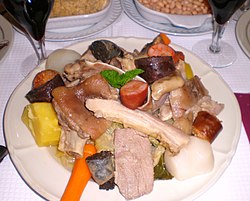

This is a list of Portuguese dishes and foods. Despite being relatively restricted to an Atlantic sustenance, Portuguese cuisine has many Mediterranean influences. Portuguese cuisine is famous for seafood.[ citation needed ] The influence of Portugal's former colonial possessions is also notable, especially in the wide variety of spices used. These spices include piri piri (small, fiery chili peppers), black pepper and white pepper, as well as cinnamon, vanilla, clove, cumin, allspice and saffron. Olive oil is one of the bases of Portuguese cuisine, which is used both for cooking and flavouring meals. Garlic is widely used, as are herbs, such as bay leaf, coriander, oregano, thyme, rosemary and parsley, being the most prevalent. Portuguese beverages are also included in this list.






















